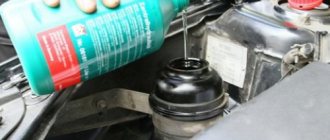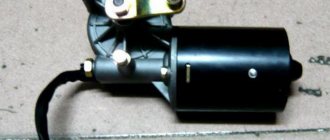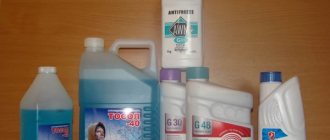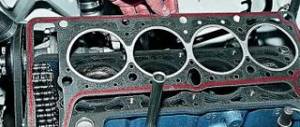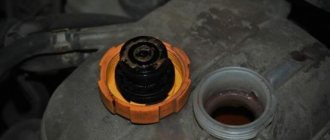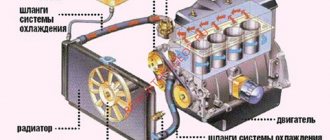In winter, when the air temperature drops below -25C, not only the water in the washer reservoir freezes (if you forgot to drain it and replace it with low-temperature liquid), but also the anti-freeze, if it is not designed for such frosts. Therefore, when choosing a windshield washer fluid, always study its characteristics on the label - it indicates the crystallization limit for concentrated anti-freeze agents.
What to do if the anti-freeze agent has frozen in the windshield washer reservoir? How to quickly defrost it so that it does not tear the nozzles and the tank itself?
How to tell if windshield washer fluid is frozen
Windshield washer fluid can freeze in severe frost in several cases:
- the windshield washer system was not completely drained of water before adding anti-freeze;
- you poured in a low-quality anti-freeze agent not intended for severe frosts or a highly diluted anti-freeze agent;
It is important to understand that frozen windshield washer fluid can destroy the entire system: the reservoir, injectors, rubber lines and washer pump. Therefore, you need to do everything to prevent this from happening, and if the liquid does freeze, quickly determine the causes of freezing and defrost the anti-freeze before it causes damage to the windshield washer system.
First, make sure that the liquid you pour into the washer reservoir is designed for very low temperatures (including extreme cooling when the car is moving). But, if the car has been standing in 30-degree frost for more than 10 hours, the probability of the anti-freeze device freezing is high.
It’s easy to check: unscrew the tank cap and make sure there is ice inside. To make sure that the liquid has frozen in the entire windshield washer system, start the car for 10-15 minutes until the engine warms up all systems (+70+80°C), then turn on the windshield washer - the liquid should almost instantly spray from the nozzles onto the glass. If this does not happen, continue to warm up the machine for another 10 minutes and try again. If the liquid does not flow again, it means that it has frozen throughout the entire system, including the pump.
The washer fluid is frozen: what to do?
The best option for defrosting windshield washer fluid is a heated garage, where the anti-freeze will thaw naturally in a few hours. If the car is parked outdoors, you will have to warm it up with the engine for at least 2 hours, or for about an hour with the built-in heated washer (if provided).
But what to do if you don’t have 2-3 hours to warm up the windshield washer system? To do this, there are several quite effective ways to defrost windshield washer fluid.
Warm up with hot water
If the anti-freeze agent is frozen in the tank and it is no more than a third full, you can try to warm it up with hot water (+50+60°C) by pouring it into the tank. Then you need to start the car and warm it up for about 5 minutes, then start the windshield washer motor. If the liquid begins to splash, it means the system is working properly. All that remains is to drain the liquid from it (disconnect the tubes from the washer distribution tee, lower it into a container and start the washer pump) and fill in new anti-freeze.
This method has only one drawback: if the lines and injectors are frozen, hot water will not help - you will still have to warm them up with the engine for at least an hour. And do not pour boiling water into the washer reservoir - it may burst!
Heating with a hairdryer
This heating method can be used when the washer reservoir is filled to the top, is completely frozen, and there is nowhere to pour hot water. To warm up, start the car engine and warm it up a little, then start heating the tank with an electric hair dryer, gradually increasing the heating temperature and pumping out the already melted liquid from the tank. After the antifreeze has completely melted and been removed from the container, fill in new liquid and check the functionality of the windshield washer system.
It is important to remember: you cannot use an electric hair dryer when the car engine is cold, and you cannot immediately turn on the hottest blowing mode - due to a sharp temperature change, the tank may crack and the paintwork under the hood of the car may crack.
Using antifreeze or alcohol-containing liquids
One of the “folk” methods is to heat the windshield washer fluid with alcohol or regular vodka. This will give a quick result, since vodka and anti-freeze are mixtures of water and alcohol, and alcohol quickly melts any ice.
You need to pour vodka or alcohol into the washer reservoir. There is no need to warm it up first - when alcohol reacts with water, it releases a large amount of thermal energy, and after a few minutes the antifreeze thaws.
In the same way, you can melt it in the washer reservoir with a low-temperature anti-freeze agent, which must first be slightly heated (no more than +40+60°C). The heated liquid should be gradually added to the top of the tank as the ice melts. Pump out the melted mixture during the process. After warming up, completely remove the liquid (it has a high crystallization temperature) and fill in with a high-quality anti-freeze agent, warm up the engine and pump the windshield washer system.
Motor heating
This method does not require any additional tools or chemical compounds. The car just needs to be warmed up to 80°C with the hood closed (you can lay plastic film on top). After this, turn off the engine and check the operation of the windshield washer system.
If the liquid does not splash out, it means that the entire system is frozen. Warm up the engine for another 10 minutes, then try again. If this time the nozzles do not work, the washer pump has failed.
This method of heating is not very effective - it does not melt the ice in the lines and pump, and it requires at least 2 hours for the anti-freeze to completely thaw if the car is located outside and not in a box. Therefore, experts recommend using several methods at once to warm up the windshield washer fluid in the reservoir and washer lines. For example, heat the system with the engine and the tank with a hairdryer, or pour warm anti-freeze into the tank and start the engine to warm up.
How to quickly defrost water in the windshield washer reservoir
Similar articles
- Recommendations for winter car operation
- Why does my battery drain quickly?
- Why the car overheats: looking for reasons
Every real driver looks forward to the onset of winter, preparing for it in every possible way. Some change the battery, some change the spark plugs, some change the antifreeze, and almost everything - engine oil and tires, and some do everything at once. And this is correct, because most of us live in a climate zone with fairly severe winter weather; it would be naive to expect that winter will pass by this year.
Let's imagine the morning of some ordinary driver who diligently prepared for winter, replacing all the necessary consumables before it, spending a sufficient amount of effort and time on this. And finally, waking up in the morning, he notes, not without pleasure, that the X-hour has come! The first, uncertain, but very slippery snow lies on the ground, and the car is a small snowdrift with ice on all the windows at once. Quietly laughing at those who drive out of the yard “half-sideways” without having time to “change their shoes” from summer tires to winter ones, and at those who did not change the dying battery for a new one, and are now jumping from car to car asking “let me light a cigarette, just wires” no,” our hero approaches his own car, ideally prepared for winter, triumphantly turns the key in the ignition, and, with an air of complete superiority, begins to sweep away snow from the roof of the rumbling car with a specially prepared brush. Having shaken off the snow, the driver gets behind the wheel and drives out of the yard on slippery asphalt on winter tires without any problems, smiling and catching the envious glances of those who couldn’t start and those for whom the slightest uphill climb on summer tires gives them a headache.
Having reached the road, our hero discovers that the weather is not yet so cold that all the dirt has frozen. On the contrary, it, lifted by the wheels of passing cars, hangs in the air in the form of a fine dirty fog that instantly envelops the windshield. But is this a reason for frustration if there are winter (or frameless) wipers?! Not at all! The driver boldly and fearlessly throws them into the battle to keep the glass clean, but after a few moments they only smear the dirt. “It’s no problem,” our hero thinks to himself, “now we’ll help them with some water,” with these thoughts he pulls the lever for supplying water from the washers to the windshield, and here comes the moment of truth. Most often, nothing happens at this second - no water flows anywhere! What's the matter? And the fact, dear ones, is that our hero, like most other drivers, forgot to fill the washer reservoir with anti-freeze liquid, and all the water in the washer reservoir froze and does not flow into the nozzles on the hood!
What to do in this case? From now on, we will no longer talk about our “virtual” driver friend, and will move on to practical solutions.
So, the first thing to consider is how much water was in the tank. If it is full to the brim, there is ONLY one way out - go to a warm room (for example, a car service center or car wash) and wait until the ice melts. If this is not done at all, then the chances of thawing remain only with the possibility of a thaw, and since winter is just beginning, a thaw may not happen soon. Next, as soon as the system has thawed, try to expel the maximum amount out through the glass washers, and then pour anti-freeze liquid into the system, which you will use until the end of winter.
The advantages of this method are harmlessness to the system and enormous reliability. If something freezes at -2, then it will probably thaw at +20. This is the easiest method for any degree of fullness of the tank.
The disadvantages of this method are wasted time and wasted money. To be honest, there are very few service centers or car washes that will agree to let you warm up for free. Especially when you consider that you will stand in it for at least 15-20 minutes.
However, most often, there is no time for complete defrosting (you have to go!), and the washer reservoir is also not completely filled. In this case, hot water will help you. The easiest way to take it is clear where - in your own home, from which you are most likely not far away. The procedure will be as follows. You will need about one liter of hot water (preferably not boiling water, since a sudden change in temperature can cause the tank to burst), which will need to be poured into the filler neck. Do not touch the system for 1-2 minutes - let the water defrost the ice in the tank, and then try to apply water to the glass.
But this method also has a small pitfall - the fact is that water can freeze not only in the tank itself, but also in the tubes supplying water to the washer nozzles, and in the nozzles themselves, by the way, too. If the water in the tank, resulting from mixing the hot water you poured in and the melted ice, has a sufficient temperature, it can easily break through the ice plugs. As a rule, this happens on the first day of frost, when the air temperature has not dropped far below zero. If the water has found its way and the system is working, you will need to take two more important steps. First, it will be necessary to expel the maximum amount of ordinary water from the system. And secondly, buy an “anti-freeze” at the nearest auto store and replace the water in the tank with it.
The advantages of this method: fast and free defrosting.
Cons - it may not help due to freezing of water in the tubes and spray nozzles; If the method does not help, an additional liter of liquid will appear in the washer reservoir, which will freeze in the near future.
In any case, if the system does not work after washing with hot water, no one forbids you to go into a warm room to warm up.
Summary. If you forgot to replace the washer fluid in the washer reservoir, this is a problem, but not a big deal. The liquid itself will not thaw if the outside temperature is below zero, no matter how hard you try to warm up your car. The fact is that the tank is located quite far from the engine - as a rule, in a niche under the wing, and is not heated by anything.
The main thing is not to despair and not to panic. You can try to defrost it in at least two ways. Hot water will give you the opportunity to correct the situation right near your home. If this does not help, go to a warm room. The main thing is not to forget to remove the water from the system after defrosting and replace it with a non-freezing liquid.
PS In one of the reviews to this article, a rational proposal was made - if time permits, instead of going to a service center or a car wash, you can go to the warm underground parking that modern shopping centers are equipped with. One hour is enough for complete defrosting. And it will be free!
Hondavodam.ru
If you find an error, please select a piece of text and press Ctrl+Enter.
More interesting articles
What not to do if the liquid is frozen
Warming up windshield washer fluid is a labor-intensive procedure that requires great care and compliance with safety precautions. When heating a frozen antifreeze, you must not:
- create strong temperature changes so as not to damage the components of the glass washing system (the use of boiling water, open fire, and strong heat is excluded);
- if the windshield washer reservoir is located above the wing of the car, prolonged warming up of the engine will not help - you will only burn the fuel: combined heating methods should be used here;
- All stages of heating the anti-freeze should be performed slowly and with pauses so as not to damage the frozen pump (impeller and washer pump motor).
How to avoid liquid freezing?
As mentioned above, prevention is always safer and simpler than radical rescue measures. To prevent windshield washer fluid from freezing in the reservoir and the rest of the system, you should:
- drain the water in a timely manner and replace it with anti-freeze before the onset of severe cold, with mandatory pumping through the lines, pump and nozzles;
- pour only concentrated frost-resistant anti-freeze with a low crystallization temperature into the washer reservoir (take into account the average air temperatures on your face in your region and carefully read the manufacturers' recommendations on the labels);
- refuse to dilute the antifreeze with the onset of frost;
- minimize the time the car is outdoors in severe frosts (either garage or use hood coverings);
- install heating on the windshield washer system (it is installed standard on almost any car model).
In conclusion, it should be noted that frozen windshield washer fluid in a car is an unpleasant situation that can affect the quality of cleaning the windshield, reducing visibility of road traffic and driving safety. In addition, frozen anti-freeze can rupture the washer reservoir and damage the lines and pump in the windshield washer system.
The problem of frozen windshield washer fluid can be solved either slowly and reliably (by heating an insulated garage) or quickly, but with a high risk of damage to the components of the windshield washer system. There are several proven methods for this - pouring hot water, low-temperature anti-freeze or alcohol into the tank, as well as using an electric hair dryer or deep warming up the system with the engine. All methods are effective, but require care and caution.
Methods for defrosting the washer system
To defrost the washer system, you can use several options:
- take your car to a heated car wash;
- add vodka, or better yet alcohol, to the tank;
- add heated high-quality frost-resistant anti-freeze with a threshold of up to - 40 degrees Celsius into the tank;
- use an electric hair dryer.
The latter option can cause deformation of the plastic elements of the washer system (tank, tubes and pipes), so it should be used extremely carefully.
But the first three can be combined, which will allow you to achieve maximum effect. In particular, after warming up frost-resistant anti-freeze or alcohol on a battery, in a bathtub or in another convenient way (on a car engine), the liquid, as far as possible, should be poured into the frozen washer system reservoir. Place the car in a heated parking lot or take it to a car wash, preferably a manual one. Turn on the heated glass and the interior heater, directing the warm air down onto the lying container with warm anti-freeze. So to speak, to maintain the liquid in a heated state. After the time has passed, add a new portion of warm liquid into the partially freed container. It is necessary to repeat the manipulation until the tank completely melts and the washer fluid can flow through the nozzles onto the windshield. Based on the result, drain the thawed water from the tank and fill it with frost-resistant liquid.
In general, in order to prevent the water from freezing in the washer system, you simply need to be careful and, in time with the onset of cold weather, pour a frost-resistant anti-freeze agent purchased in advance into the washer system.
